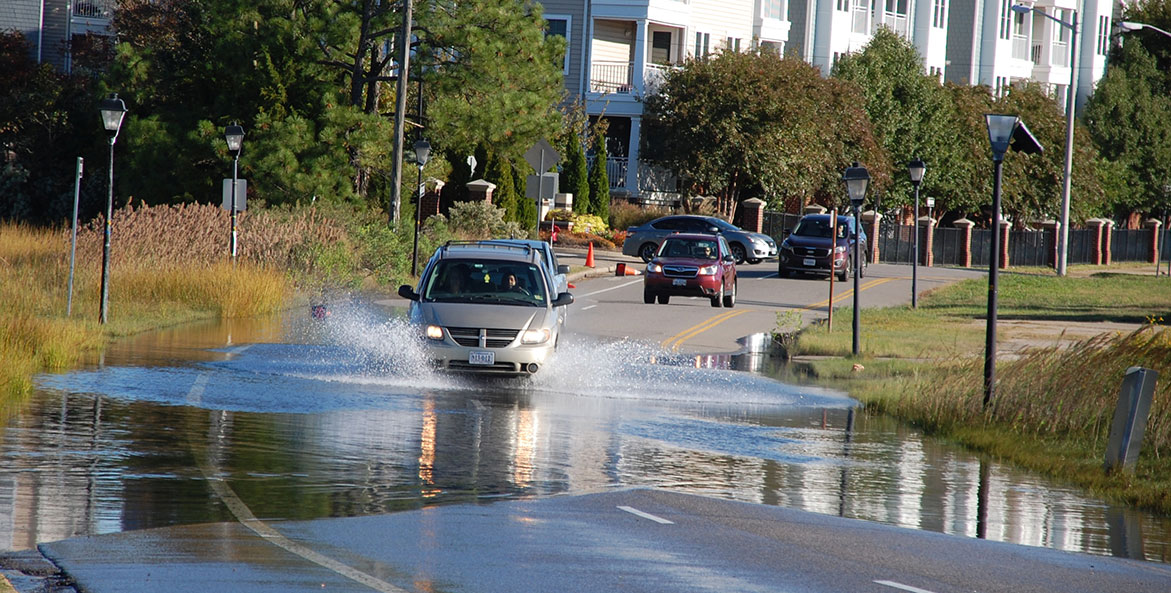The following commentary was originally published in the Virginia Mercury on January 31, 2024.
Two floods hit Southwest Virginia eleven months apart, threatening the lives of some Buchanan County residents. The first flood in August 2021 knocked more than 20 homes from their foundation and killed an 85-year-old woman.
Even on sunny days, some drivers in Hampton Roads—the region with the highest rate of sea level rise on the East Coast—navigate flooded roads. For sale signs dot neighborhoods sitting on frequently flooding streets.
According to experts at the First Street Foundation and Climate Central, the roadways and metro station near a proposed sports stadium in Potomac Yard could be at risk of flooding. If the arena materializes, Washington Wizards and Capitals fans may have to battle swamped streets and flooded metros to get to their beloved games.
Climate change is no longer knocking at Virginia’s door; it’s inside the commonwealth’s house—with no plans to leave.
Protecting Virginians from this urgent situation requires resilient solutions. And resilient solutions need consistent investment.
Yet, in this respect, Virginia is falling behind. The state’s withdrawal from the Regional Greenhouse Gas Initiative (RGGI) late last year effectively shut off the only statewide funding source for community-based resiliency projects.
In this legislative session, state lawmakers can’t afford to let these community-scale efforts grind to a halt. Without more investment, state experts working on these issues could lose funding and projects in the pipeline could be delayed.
Now is a time we should be urgently ramping up this work, not throwing obstacles in its way.
Fortunately, legislators need not reinvent the wheel. A funding mechanism called the Community Flood Preparedness Fund (CFPF) already exists, but without RGGI it won’t have any new investment unless legislators act. Lawmakers could allocate $200 million over the two-year budget to this program and support the budget amendments requested by House Majority Leader Charniele Herring, D-Alexandria, and Senate Majority Leader Scott Surovell, D-Fairfax, that require Virginia to rejoin RGGI.
These are effective ways to keep shovels in the ground. Millions of dollars from RGGI, the multistate, market-based effort, funded projects across the state while reducing carbon emissions.
Buchanan County, the Southwest Virginia community hit with those two floods, was one of the first localities to tap into RGGI funds. The money allowed the county to work with a professional engineering team to build flood resilience capacity and engage the community in a natural resource management planning effort.
But Buchanan County isn’t the only one. More than 80 projects are underway statewide, ranging from living shorelines to stormwater-retaining public spaces to voluntary acquisitions for flood-prone properties. The work spans rural communities in Southwest Virginia to Richmond, all the way to densely populated Fairfax County and on to the Eastern Shore.
These essential efforts can progress with adequate funding. Importantly, the flood preparedness fund prioritizes nature-based solutions and comes with built-in equity guardrails, key factors in sustainable climate adaptation solutions.
Nature-based solutions—like living shorelines that rely on native plants and grasses to prevent erosion—provide benefits beyond flood control, such as public recreational spaces and pollution reduction.
As for equity, a quarter of the money in the flood preparedness fund goes toward communities defined by the state as low-income: those with a median household income not greater than 80 percent of the local median household income.
Communities need support for their praiseworthy efforts to defend residents from flooding caused by extreme storms and sea level rise. Rather than reacting to climate disasters, this work can pave the way for the state to serve as a leader on this pressing national issue.
This legislative session, new and returning elected officials can protect their constituents from growing flood risk and disastrous storm effects by investing in the flood preparedness fund and supporting the budget amendments to return Virginia to RGGI.
Climate change isn’t going anywhere. Instead of moving backward, it’s time for Virginia leaders to fund the future of climate adaptation.




